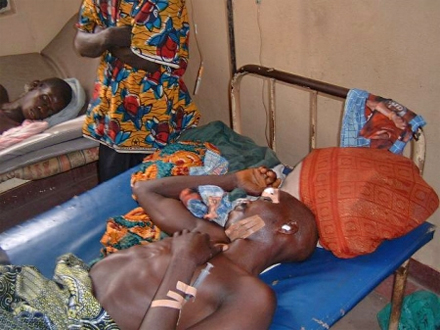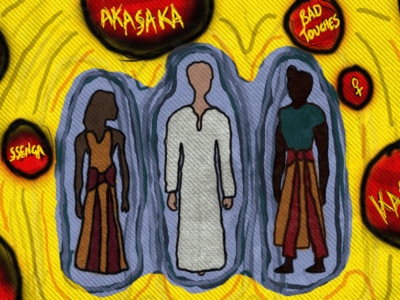While fighting in North Kivu – which displaced 250,000 people earlier this year – has been somewhat quiet of late, there are now reports of mass killings in a different part of Congo. The Lord's Resistance Army (LRA), a Ugandan rebel group, has gone on a rampage in the Haut-Uélé region in northeastern Congo, near the Sudanese border. The attacks are in response to recent military operations against the LRA bases in the surroundings of the Garamba National Park, launched in December by Ugandan, Southern Sudanese and Congolese forces. According to the NGO Caritas, over 400 people have been killed around the towns of Faradje, Duru, Bangade, Gurba, and Doruma since the 25th of December:
The Director of Caritas Dungu-Doruma says that the Ugandan rebels attacked a Christmas Day concert in Faradje City organised by the Catholic church there. He says the rebels returned the next morning to continue their killing spree. He says approximately 150 people were killed over the two days.
At the same time, another attack was perpetrated in Duru, north of Dungu. Caritas reports 75 people killed and the Church burned down.
Caritas reports that the killing continued along the Sudan border, including in Bangadi, Doruma and Gurba. Caritas reports 48 dead in Bangadi and that in Gurba 213 people were killed. Approximately 6,500 people have found refuge in the area with the Catholic church.
Caritas also reports that children are being abducted by the LRA, who use them as child soldiers.
The MSF (Doctors without Borders) team in Dungu received the following report from the town of Faradje:
First information on the attack on Faradje, a city of 25,000 people in northeastern DRC, reached the MSF team in Dungu on the evening of Christmas Day. […] On the following morning, a nurse form Tadu, a small town 20 km south of Faradje, signaled by radio the arrival in his area of thousands of people fleeing the attack, probably around 15,000. The nurse confirmed that Faradje’s head physician and another civil servant had been killed in the attack. According to him, many seriously wounded victims were still stuck in the city’s hospital, which was left without proper equipment following looting by LRA soldiers.
The Caritas blog posted three pictures of survivors from the Christmas day killings in Faradje by Emmanuel Bofoe:

(Photo by Emmanuel Bofoe of Caritas Internationali)
The conservation blog Baraza of the WildlifeDirect network reported an LRA attack in the headquarters of Garamba National Park on January 2nd:
Despite strong resistance by the park rangers together with elements from the Congolese Armed Forces, numerous casualties and material damages have been incurred. A first report mentions 8 people killed, including two park rangers and two wives of wardens, and 13 injured, most of them by bullets. An unconfirmed number of rebels have also been killed or wounded.
Several essential buildings of the headquarters have also been destroyed, along with many items of transport and communications equipment, and stocks of fuel and food rations.
In a different post, the Baraza blog described the situation in the area as “much worse than before”:
One person has described the outcome of this failed military offensive against the LRA as the equivalent of “stirring up a hornets nest”
Dahee Nam at Impunity Watch Africa reports that on Sunday December 4 another attack was launched in the region but no casualties occurred since the targets had fled before the rebels arrived.
Michael Kleinman of the Humanitarian Relief blog comments on the humanitarian situation in the area:
In addition, as many as 30,000 villagers have fled the area. According to a recent IRIN article – Deadly LRA attacks prompts exodus in northeastern Congo – aid agencies are struggling to reach those in need: “The military operations and the LRA presence make it very difficult for humanitarian agencies to operate, and some areas are currently totally inaccessible to aid workers.”
Kakaluigi [Fr], an Italian missionary working in Eastern Congo, compares the media reaction to these massacres in Eastern Congo to the recent ones in Gaza in a post titled “Scandal!“:
À Gaza ( Palestine) les Israeliens viennent de massacrer 400 personnes en l'espace d'une semaine, il y'a eu manifestation à travers le monde et les mèdias de tout genre ne font que nous bombarder avec leurs images de sang et de morts.
À Dungu- Faradje (RDC) c'est en presence de la Monuc que la Rébellion Ougandaise vient d'assassiner plus de 400 personnes en l'espace d'une journée, mais silence total à travers le monde, pas une image et même pas une journée de deuil au pays concerné.
In Dungu-Faradje (DRC), in the presence of Monuc Ugandan rebels have just assassinated over 400 people in a day, but there has been complete silence all over the world, not one image and not even a day of mourning in the affected country.
In a similar vein Hugues Serraf, blogging at La tribune du vaticinateur [Fr] of Rue 89, wonders:
Si un mort israélien vaut plusieurs morts palestiniens, combien faut-il de cadavres congolais pour un linceul gazaoui?
[…] Comment un conflit qui a déjà fait quatre millions de morts en dix ans, et tue encore plus d’un millier de civils chaque jour du fait du chaos alimentaire et sanitaire qu’il entraîne, peut-il être aussi peu couvert? Comment les 271 victimes de la LRA (hypothèse basse, rappelons-le) de ces dernières semaines ont-elles pu échapper à la vigilance de nos reporters, de nos analystes, voire de nos manifestants?
[…] How come a conflict that has already caused four million deaths in ten years, and that is still killing more than a thousand civilians every day as a result of the food and health crisis that it is causing, can receive such little coverage? How come the 271 victims of the LRA (a low estimate, let's not forget it) of the last couple of weeks could slip out of the vigilance of our reporters, analysts, even our demonstrators?
Stop the war in North Kivu, a blog written by an international aid worker in Eastern Congo, reflects on the “ignorance of African wars by Western public opinion and Western media”:
I am convinced that the thunderous silence of Western media regarding horror in African conflicts entails an enormous, and unavoidable, ethic question. If five million people die in a given place, we as human beings have the obligation to know that this has happened. It is a moral obligation. We must know, the same way that we all know that millions of Jewish men, women and children were exterminated in Germany in the Second World War. However, we don´t know that more than five million Congolese have died as a result of the war since 1998.
Citizens of an information age have a right to know about it, and victims have a right for their suffering to be told, and known.







14 comments
There is a fundamental problem in viewing media attention only as a zero sum game. It is no comfort for the people of Gaza that people in DRC are slaughtered, likewise it doesn’t help people in the DRC that Palestinians in Gaza are killed. What is needed is that the international community acts to defend and uphold the principles of the Geneva Conventions, safe-guarding civilians in all conflicts.
It is important to put pressure on Western countries such as USA and Israel, since their behaviour in the ‘war on terror’ is utilized to legimitize human rights abuses and restrictions around the world.
Also, the Gaza and DRC conflicts are not entirely separate. The Israeli state intelligence apparatus propped up the Mobutu dictatorship for years, laying the foundations for further conflicts in the country. Israeli interests are actively involved in the plundering of DR Congo’s natural resources, in liason with European actors.
http://gaza-peace-n-freedom.blogspot.com/2009/01/michel-hamas-is-responsible.html
Great work, I like your use of first hand experience from various sources.
BRE – consonance in coverage is very important i news media, for sure. But I also think tragedy/negativity, and extreme trauma, would normally dominate this. 400 people killed in one day, on Christmas day no less, should make the news – it would if it occurred in Europe or the USA.
As for global media differences, quite a few studies have shown that they still focus on elite nations – even in Africa reporting has often been criticised for focusing too much on the USA and Europe.
I’m starting a blog now which is going in-depth into this, I’d appreciate any involvement from you guys and this needs to be all over the net.